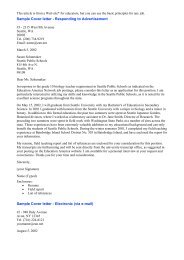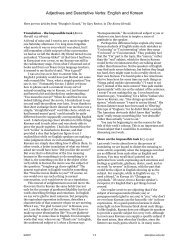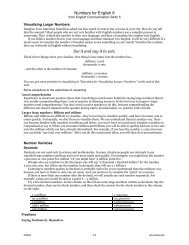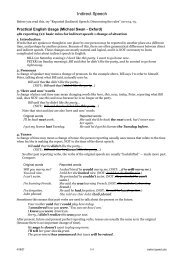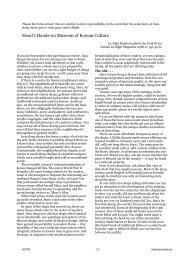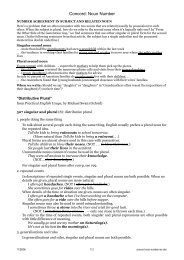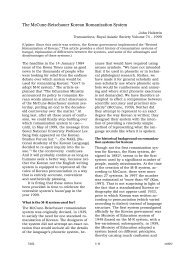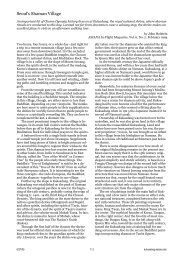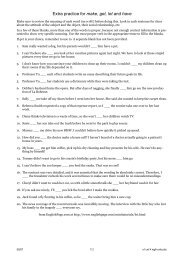Oral Presentations (International English Skills 1 ... - Korea Mosaic
Oral Presentations (International English Skills 1 ... - Korea Mosaic
Oral Presentations (International English Skills 1 ... - Korea Mosaic
You also want an ePaper? Increase the reach of your titles
YUMPU automatically turns print PDFs into web optimized ePapers that Google loves.
we discovered was that government employees have various ways of making money in addition to their<br />
salary."<br />
Remember that a point is not merely a topic; a point is a statement about a topic. Each major point in your<br />
intro, therefore, should be given a sentence or at least a clause. This will make it more probable that the<br />
audience will pay attention, and it will help the audience more completely understand.<br />
Section summaries<br />
If your audience were able to read what you are telling them in your oral presentation, they could go back and<br />
read again. We often do that when we don’t understand something clearly or when we want to be sure to<br />
remember something that we just read. Provide that opportunity for each content section when you make an<br />
oral presentation. Section summaries remind your audience of the major supporting point you have just<br />
finished presenting, they give your audience time to digest what you have just told them, and they signal and<br />
prepare the reader for your next section. First, restate your major point, then repeat the major supports, and<br />
then remind your audience of the point’s relation to the main point of your whole presentation.<br />
Do you remember what we have said about a point not being a topic Re-read the second paragraph of<br />
“Section intros,” about giving enough attention to each intro point. The same goes for points in section<br />
summaries. At the end of your presentation of background, for example, present a summary that, like the<br />
introduction, gives each point at least one clause. Also provide an introduction about what is coming next.<br />
“Now that you know the background details of our negotiations, let us go on to an observation of major<br />
developments in the negotiations.”<br />
Quick Tip: Repetition = Retention<br />
by Bill Wilson <br />
The Universal Speaker's Law says: (1) Tell them what you're going to tell them, (2) Tell them, and (3) Tell<br />
them what you told them. And, while you're telling them, tell them over and over again. Certainly, you don't<br />
want to repeat the same thing over and over again…to your audience, you'll sound like fingernails on a<br />
blackboard. But you can make an important point and use several different illustrations to drive that point<br />
home. Listen to the pro's sometime and you'll see this done expertly.<br />
Why do you have to be so repetitive Simple...if you want the audience to remember the important points<br />
in your message, you have to make each point in 3-6 different ways. According to one study, if you make a<br />
point only one time, at the end of your presentation, just 10% of the audience will remember it. If you repeat a<br />
point six times, retention jumps to 90%. Without repetition, 40% of your audience will forget virtually<br />
everything you said within 20 minutes of your conclusion. Within 24 hours, 70% of the audience will forget<br />
almost 100% of your message.<br />
Reality check: If you don’t have the time to repeat things several times, at least make sure to repeat major<br />
points in your summary at the end of each section of your presentation.<br />
Helpful organization (from Business Communication: Process and practice)<br />
Unlike readers, the audience at an oral presentation have no chance to glance back to your earlier words in an<br />
effort to clear up confusion. The pattern of your thought must be clear from the beginning. Speakers should<br />
make a practice, therefore, of setting forth a brief outline at the beginning of the presentation as shown in the<br />
two examples below.<br />
We have to choose the type of building we want for our proposed Vancouver branch. Consider three<br />
alternatives with me: 1. The downtown remodel/renovation office; 2. The industrial park office; 3. The<br />
suburban office. Each has advantages and disadvantages.<br />
Basing her speech on this overview, the speaker goes on to treat the advantages and disadvantages of each<br />
alternative.<br />
We can plan most effectively by looking first at how we used to produce the K-14; then, at how we now<br />
produce it, using computer-aided design techniques; and, finally, at our production needs in the five<br />
years ahead.<br />
This speaker will work from past to present to future. At every point in the presentation, listeners will know<br />
where they are, where they have been, where they are going.<br />
Because attention spans even in highly intelligent and interested audiences rarely exceed thirty seconds at a<br />
stretch, speakers do well to provide occasional reminders of where they are in the announced outline. A good<br />
reminder looks back to where the speaker has been, and forward to what lies ahead.<br />
So much for the urban remodel/renovation office. We can now discuss the second alternative, the<br />
industrial park office.<br />
8/30/07 6/ 18 e6_e5wbunit4-web.doc



